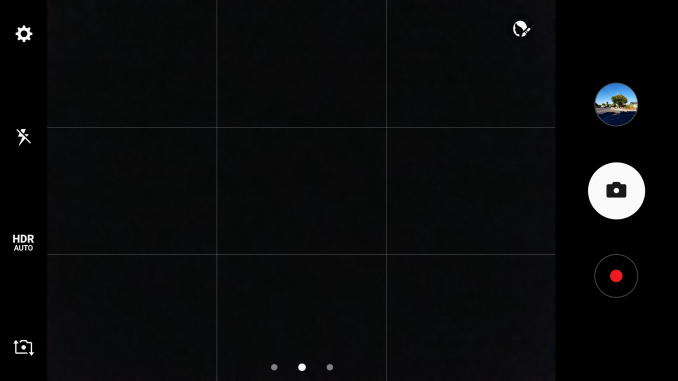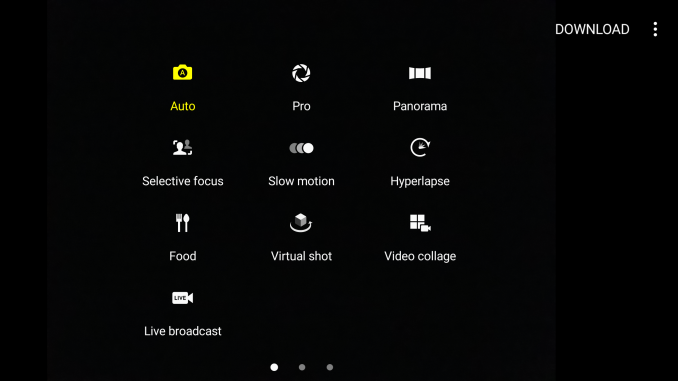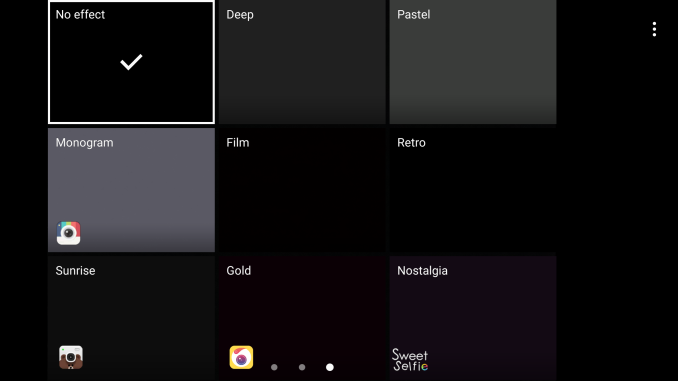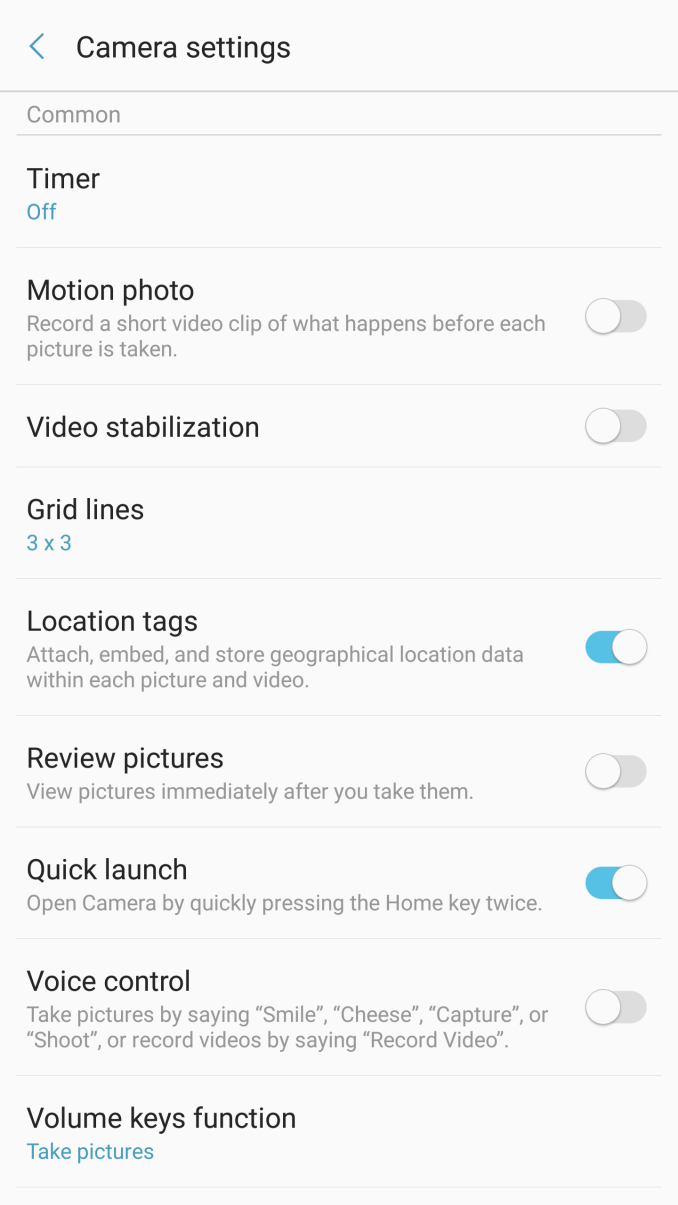The Samsung Galaxy Note7 (S820) Review
by Joshua Ho on August 16, 2016 9:00 AM ESTCamera Architecture
In general, camera has become probably the single biggest point of differentiation between smartphones at this point. As smartphones are often the only camera that most people carry on a day to day basis, the rear camera on a smartphone really cannot be a disappointment relative to the competition. While we can talk about how much a front-facing camera matters in terms of quality, it’s pretty safe to say that for photos and videos that are worth saving will be taken with the rear-facing camera.
While post-processing and a number of other factors are going to have a huge impact on the overall camera experience, the foundation that makes it possible to deliver a great camera is always going to start at the hardware.
| Samsung Galaxy Note Cameras | ||||
| Galaxy S6 Galaxy Note5 |
Galaxy S7 Galaxy Note7 |
|||
| Front Camera | 5.0MP | 5.0MP | ||
| Front Camera - Sensor | Samsung S5K4E6 (1.34 µm, 1/4") |
Samsung S5K4E6 (1.34 µm, 1/4") |
||
| Front Camera - Focal Length | 2.2mm (22mm eff) | 2.1mm (21mm eff) | ||
| Front Camera - Max Aperture | F/1.9 | F/1.7 | ||
| Rear Camera | 16MP | 12MP | ||
| Rear Camera - Sensor | Sony IMX240 Samsung S5K2P2 (1.12 µm, 1/2.6") |
Sony IMX260 Samsung S5K2L1 (1.4 µm, 1/2.6") |
||
| Rear Camera - Focal Length | 4.3mm (28mm eff) | 4.2mm (26mm eff) | ||
| Rear Camera - Max Aperture | F/1.9 | F/1.7 | ||
It’s probably not any surprise that the Galaxy Note7 has the same exact camera setup as the Galaxy S7, but in case it was ever in doubt it shouldn’t be now. Given the similar camera setup I don’t think that there’s a ton of difference to be expected between the two phones but things like software algorithms can and do change with time so it’s important to not just immediately write off the Galaxy Note7 or assume it’s immediately going to be award-winning. It’s worth reiterating here that the dual pixel system likely incurs a sensitivity penalty as in order to implement the dual pixel system each pixel must have a physical light barrier as you need a microlens and a barrier to make light from the same object converge on two separate photodiodes so the amount of light collected is inherently going to be less than no barrier and a single photodiode per pixel. I’m also curious to know whether any quantum effects appreciably change sensitivity here as if a single pixel is a 1.4 micron square then each photodiode has area similar to a 1-micron pixel. With that said we can move on to the one major change highlighted by Samsung, namely the user experience.
Camera UX
One of the major points highlighted in the launch event was that the camera application was completely redesigned. In addition to a fairly subdued icon that better fits the color palette for Android in general, the UI itself is a bit cleaner out of the box.
Right away when you open the camera app the most apparent thing is that the number of icons has been reduced. Instead of a dedicated mode button it’s now a swipe, and the same is true of the effects button. There’s also no more timer or resolution button on the screen by default, and the button to hide the various settings buttons has been eliminated entirely. It’s also worth mentioning that the button to change between cameras has been moved and a gesture to do the same thing has been added so you can simply swipe up or down to switch between cameras. Samsung also continues to shut off the camera after a few minutes automatically which is good if you’re a normal user but annoying if you’re trying to set up a shot of an ISO chart with a tripod.
Other than these changes almost nothing else really changes. There are some extra toggles like shape correction in the settings overflow and RAW output is now hidden under Picture Size for the rear camera but nothing else is really notable. I don’t really have anything else to say here that’s new, and I would refer to the Galaxy S7 Part 2 review if you are otherwise unfamiliar with Samsung’s camera application. As both perform identically as far as focus and capture speed goes subjectively we’ll temporarily forgo these results in favor of timeliness for this review.















202 Comments
View All Comments
polbit - Wednesday, August 17, 2016 - link
So it's an honest review because they criticize the phone? That's an interesting honesty test.Pdajah - Wednesday, August 17, 2016 - link
Like many other reviewers, i don't think you really appreciate whu the Note devices are so popular. It not about comparing hardware or size or software features etc. It is about the complete package and no other device offers this package and therefore your comparators and not helpful nor relevant to the millions and millions of Note users who need a highly productivity focused device. I can easily justify $200 as I'll achieve that in productivity in 2 weeks of using the Note 7 over the S7 Edge.vidal6x6 - Wednesday, August 17, 2016 - link
Why not compare xiaomi redmi note 3 pro i have one and play 7 8 hours to drain the batery samsung biased review! f&^&^anandtech!Ian Cutress - Wednesday, August 17, 2016 - link
You mean the review we posted a couple of weeks ago?http://www.anandtech.com/show/10463/xiaomi-redmi-n...
HollyDOL - Wednesday, August 17, 2016 - link
But but, can in serve as an emergency oar?BrokenCrayons - Wednesday, August 17, 2016 - link
With a 5.7 inch screen? Yes, you can tape it to the end of a stick and row your boat with it. :)winjay - Wednesday, August 17, 2016 - link
I expected a section on PenTile subpixel image rendering, considering how DisplayMate was gushing about it. Apparently there are algorithms which convert RGB subpixel rendering to RGBG. Oculus rift aparently uses subpixel rendering for VR on its Pentile dislay, though I'm not sure about that fact.Also, no attempt at covering HDR and the (possibly gimicky) app-agnostic "video enhancer" option?
Tylanner - Wednesday, August 17, 2016 - link
Bravo on the opening pictures. They plainly shows the appeal of this device without a single word.I want one
polbit - Wednesday, August 17, 2016 - link
Your reviews are usually what I anticipate the most, as they tend to be well done. I have to say however that I am shocked at your 'merely acceptable' comment about design, because as a 6S Plus owner, after playing with Note 7 at a Verizon store, I find it to be the best looking phone I've ever touched. It is truly beautiful, and makes my 6S Plus look pedestrian by comparison.I think pretty much every other review supports the design aspect of Note 7, Anandtech being the lone wolf in talking it down. Maybe it's time for someone else at Anandtech to evaluate the aesthetics from now on? I have to say that this review has definitely soured my trust of future commentary here...
henrybravo - Wednesday, August 17, 2016 - link
Agreed. The Note 7 and S7 Edge are the best designed phones out there by far. Even The Verge who many claimed to have an Apple bias said so. To read the comment, "Overall, the design of the phone is acceptable, but honestly at this point it’s nothing really special." is pretty funny."We can argue about how Apple uses a plastic liner or whatever minute detail in the design is 'better' ” - LOL no one is arguing that.